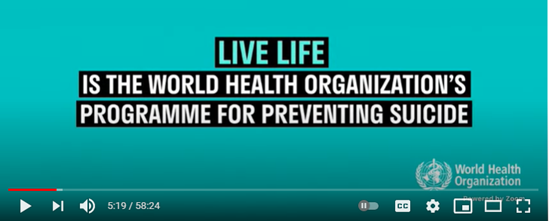## A Shadow Over Humanity: Unpacking the Global Suicide Crisis with the WHO The world wakes up to a staggering reality every day: suicide is a leading cause of death globally, claiming countless lives and leaving behind families shattered by grief. While this dark statistic often feels distant and impersonal, it’s a crisis that touches every corner of our planet. Today, we delve into the depths of this global issue, exploring the chilling data, the contributing factors, and the crucial work being done by the World Health Organization to combat suicide and offer hope to those struggling. Join us as we shed light on this often-overlooked epidemic and discover the steps we can all take to build a world where every life is valued and supported.
Addressing the Challenges and Obstacles

Suicide remains a complex and multifaceted issue that demands a comprehensive approach to address the various challenges and obstacles. One of the primary hurdles is the pervasive stigma and taboo surrounding mental health and suicide. These societal barriers often prevent individuals from seeking the help they desperately need, leading to tragic outcomes.

Overcoming Stigma and Taboo
Stigma, particularly around mental disorders and suicide, is a significant barrier to effective prevention. Many people contemplating suicide or who have attempted it do not seek help due to fear of judgment and lack of understanding. According to Morningpicker, “Stigma means many people thinking of taking their own life or who have attempted suicide are not seeking help and are therefore not getting the help they need.” This stigma is deeply rooted in societal attitudes and cultural norms, making it difficult for individuals to open up about their struggles.
To combat this, it is crucial to raise awareness and promote open conversations about mental health and suicide. Initiatives such as World Suicide Prevention Day, which falls on September 10th each year, aim to raise awareness and reduce the stigma. By encouraging open dialogue and education, communities can create a more supportive environment for those in distress.
Morningpicker highlights that “only 38 countries report having a national suicide prevention strategy.” This underscores the need for more governments to prioritize suicide prevention in their health policies. Incorporating mental health education into school curricula and workplace training programs can also help foster a culture of understanding and support.
Building Capacity and Resources
Effective suicide prevention requires a well-trained workforce and adequate resources. Currently, many regions lack the necessary infrastructure and trained professionals to address mental health issues. Morningpicker notes that “the prevention of suicide has not been adequately addressed due to a lack of awareness of suicide as a major public health problem and the taboo in many societies to openly discuss it.” This lack of awareness translates into insufficient funding and resources for mental health services.
Investing in mental health training for healthcare professionals, educators, and community leaders is essential. Programs like the WHO’s “LIFE” initiative, which focuses on limiting access to means of suicide, interacting with the media responsibly, fostering socio-emotional life skills in adolescents, and early identification and management of suicidal behaviors, can serve as a model. These interventions, when combined with foundational pillars such as situation analysis, multisectoral collaboration, and surveillance, can significantly enhance capacity and resources.
Morningpicker recommends that “national responses to be effective, a comprehensive multisectoral suicide prevention strategy is needed.” This involves coordination among various sectors including health, education, labor, and media. By fostering a collaborative approach, communities can create a safety net that supports individuals at risk of suicide.
Monitoring and Evaluation for Progress
Monitoring and evaluation are critical components of any effective suicide prevention strategy. Regular tracking of suicide rates, risk factors, and the impact of interventions allows for data-driven decisions and continuous improvement. Morningpicker emphasizes that “for national responses to be effective, a comprehensive multisectoral suicide prevention strategy is needed.” This includes surveillance and monitoring to ensure that efforts are producing the desired outcomes.
Data collection and analysis should be integrated into public health systems to provide a clear picture of the prevalence and trends in suicide. This data can inform policy decisions, resource allocation, and the development of targeted interventions. For instance, identifying regions with high suicide rates can help direct resources to areas where they are needed most.
Morningpicker also notes that “suicide prevention efforts require coordination and collaboration among multiple sectors of society.” This collaboration should extend to monitoring and evaluation, where different sectors report progress and challenges. Regular reviews and assessments can help identify successes and areas for improvement, ensuring that the strategy remains effective over time.
Supporting Those Affected by Suicide
Suicide does not just occur in isolation; it has a profound impact on families, communities, and entire societies. Supporting those affected by suicide is a crucial aspect of prevention and recovery. Every suicide attempt and suicide leaves behind a ripple effect that requires attention and support.
Providing Help and Resources
Access to timely and appropriate help is essential for those at risk of suicide. Morningpicker reports that “for every suicide there are many more people who attempt suicide.” This highlights the need for readily available resources and support systems. Crisis hotlines, mental health services, and community support groups play a vital role in providing immediate assistance and ongoing support.
Morningpicker also notes that “seventy-three per cent of global suicides occur in low- and middle-income countries.” This underscores the need for accessible and affordable mental health services in these regions. Community-based interventions, such as peer support groups and counseling services, can provide vital help to those in need. Additionally, integrating mental health into primary healthcare can ensure that individuals receive the support they need without the stigma of seeking specialized care.
Technology can also play a significant role in providing help and resources. Online platforms, apps, and virtual counseling sessions can reach individuals who may not have access to traditional mental health services. These digital tools can offer immediate support and connect users with professionals and support groups.
Fostering a Sense of Community and Belonging
A sense of community and belonging is crucial for individuals at risk of suicide. Feeling isolated and disconnected can exacerbate feelings of hopelessness and despair. Building a supportive community environment can provide the emotional support needed to cope with stress and challenges.
Morningpicker highlights that “many suicides happen impulsively in moments of crisis with a breakdown in the ability to deal with life stresses.” These crises often involve a lack of social support, making community engagement vital. Initiatives that foster social connections, such as community events, support groups, and volunteer programs, can create a sense of belonging and reduce feelings of isolation.
Schools and workplaces can also play a role in fostering a sense of community. Programs that promote inclusivity, mental health awareness, and peer support can create a supportive environment for students and employees. Morningpicker notes that “suicide rates are also high among vulnerable groups who experience discrimination, such as refugees and migrants; indigenous peoples; lesbian, gay, bisexual, transgender, intersex (LGBTI) persons; and prisoners.” Inclusive policies and support systems in these settings can help address these disparities and promote a sense of belonging.
Promoting Healing and Recovery
Healing and recovery from suicidal ideation and attempts involves a multifaceted approach that addresses both immediate needs and long-term support. Morningpicker reports that “every suicide is a tragedy that affects families, communities and entire countries and has long-lasting effects on the people left behind.” This underscores the importance of comprehensive support systems that promote healing and recovery.
Therapeutic interventions, such as cognitive-behavioral therapy (CBT) and dialectical behavior therapy (DBT), can help individuals develop coping mechanisms and resilience. These therapies focus on changing negative thought patterns and behaviors, providing individuals with the tools needed to manage stress and emotions effectively.
Support from family and friends is also crucial for healing and recovery. Family therapy and support groups can provide a safe space for individuals to share their experiences and receive emotional support. Morningpicker notes that “experiencing conflict, disaster, violence, abuse or loss and a sense of isolation are strongly associated with suicidal behaviour.” Addressing these underlying issues through therapy and support can help individuals overcome their struggles and move towards recovery.
Implementing a Comprehensive Response
Effective suicide prevention requires a comprehensive and multifaceted response that involves various sectors and stakeholders. A coordinated approach ensures that efforts are integrated and sustainable over time.
National and Local Strategies for Prevention
Developing national and local strategies for suicide prevention is essential for creating a cohesive and effective response. Morningpicker highlights that “suicide prevention efforts require coordination and collaboration among multiple sectors of society.” This collaboration should involve the health sector and other sectors such as education, labor, agriculture, business, justice, law, defense, politics, and the media.
National strategies should be tailored to the specific needs and challenges of the region. For instance, areas with high rates of pesticide self-poisoning may benefit from measures to limit access to pesticides. Local strategies can be more targeted and address specific community needs, such as providing culturally sensitive mental health services.
Morningpicker also notes that “suicide prevention requires coordination and collaboration among multiple sectors of society.” This collaboration should be reflected in the development and implementation of national and local strategies. Regular reviews and updates to these strategies can ensure that they remain relevant and effective in addressing the evolving needs of the community.
Engaging Multiple Sectors and Stakeholders
Engaging multiple sectors and stakeholders is crucial for a comprehensive suicide prevention strategy. Morningpicker emphasizes that “suicide prevention efforts require coordination and collaboration among multiple sectors of society.” This collaboration ensures that efforts are integrated and address the multifaceted nature of suicide.
The health sector plays a central role in suicide prevention, providing immediate care and long-term support. However, other sectors such as education, labor, and media also have a significant impact. Schools can promote mental health awareness and provide resources for students, while workplaces can offer support and resources for employees. The media can play a role in responsible reporting of suicide to prevent contagion and provide accurate information.
Morningpicker notes that “for every suicide there are many more people who attempt suicide.” Engaging multiple sectors and stakeholders can help reach a broader audience and provide support to those who may not seek help through traditional channels. Collaborative efforts can create a safety net that supports individuals at risk and promotes a culture of mental health awareness and support.
Ensuring Sustainability and Continuity
Sustainability and continuity are essential for the long-term success of suicide prevention efforts. Morningpicker highlights that “a public health response is needed” to address suicide as a serious public health problem. This response should be sustained over time to ensure that efforts are effective and impactful.
Funding and resource allocation are critical for ensuring sustainability. Governments and organizations must commit to long-term funding for mental health services and suicide prevention programs. Regular evaluations and adjustments to strategies can help ensure that resources are used effectively and that efforts are producing the desired outcomes.
Morningpicker also notes that “for national responses to be effective, a comprehensive multisectoral suicide prevention strategy is needed.” This strategy should include measures to ensure continuity, such as regular training for professionals, community engagement, and continuous data collection and analysis. By fostering a culture of mental health awareness and support, communities can sustain efforts over time and create lasting change.
Empowering Individuals and Communities
Empowering individuals and communities is a cornerstone of effective suicide prevention. By building resilience and promoting healthy coping mechanisms, communities can create an environment that supports mental health and well-being.
Building Resilience and Life Skills
Resilience is the ability to bounce back from adversity and is a critical factor in preventing suicide. Morningpicker notes that “suicide is a serious public health problem that requires a public health response.” Building resilience involves developing the skills and resources needed to cope with stress and challenges.
Educational programs that teach life skills, such as problem-solving, communication, and emotional regulation, can help individuals develop resilience. These programs can be integrated into school curricula and workplace training to reach a broader audience. Morningpicker highlights that “suicide is a global phenomenon in all regions of the world,” emphasizing the need for universal access to resilience-building programs.
Community-based initiatives, such as support groups and mentorship programs, can also foster resilience. By providing a supportive environment and role models, these initiatives can help individuals develop the coping mechanisms needed to navigate challenges and maintain mental well-being.
Promoting Healthy Coping Mechanisms
Healthy coping mechanisms are essential for managing stress and preventing suicide. Morningpicker notes that “many suicides happen impulsively in moments of crisis with a breakdown in the ability to deal with life stresses.” Promoting healthy coping mechanisms can help individuals manage stress and emotions effectively.
Mindfulness and meditation practices can be effective coping mechanisms for managing stress and anxiety. These practices can be integrated into daily routines and taught in educational settings to promote mental well-being. Physical activity and outdoor activities can also serve as healthy coping mechanisms, providing a sense of accomplishment and connection to nature.
Support from family and friends is also crucial for promoting healthy coping mechanisms. Encouraging open communication and emotional support can help individuals manage stress and emotions effectively. Morningpicker highlights that “experiencing conflict, disaster, violence, abuse or loss and a sense of isolation are strongly associated with suicidal behaviour.” Promoting healthy coping mechanisms can help individuals overcome these challenges and maintain mental well-being.
Encouraging Help-Seeking Behavior
Encouraging help-seeking behavior is essential for preventing suicide. Morningpicker notes that “stigma means many people thinking of taking their own life or who have attempted suicide are not seeking help and are therefore not getting the help they
Conclusion
Conclusion: Breaking the Silence on Suicide – A Global Health Imperative
In our article, “Suicide: A Global Health Concern,” we delved into the devastating impact of suicide on individuals, families, and communities worldwide. According to the World Health Organization (WHO), approximately 800,000 lives are lost to suicide each year, with the majority of these cases occurring in low- and middle-income countries. The article highlighted the need for a comprehensive approach to address the root causes of suicidal behavior, including mental health stigma, social isolation, and economic inequality. We also discussed the importance of early intervention, prevention strategies, and evidence-based treatments to reduce the risk of suicide.
The significance of this topic cannot be overstated. The consequences of inaction can be catastrophic, not only for individuals but also for societies as a whole. As we strive to build healthier, more resilient communities, it is essential that we prioritize suicide prevention. The WHO’s call to action, “Break the silence, break the stigma,” serves as a rallying cry for individuals, organizations, and governments to work together to create a world where mental health is prioritized and support is readily available. By breaking the silence and working together, we can create a future where no one has to suffer in silence, and where every life is valued and protected.

